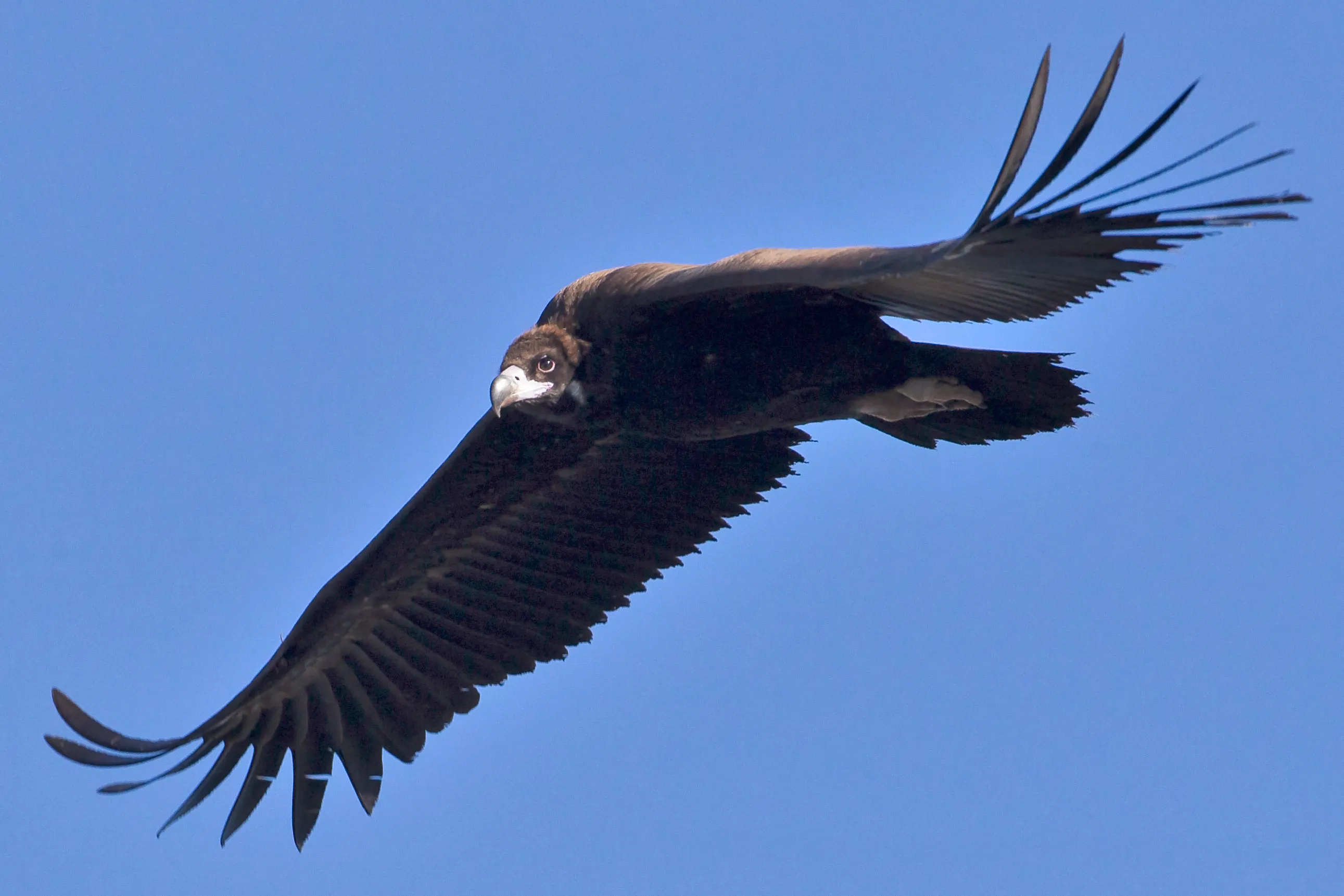
Cinereous Vulture
Cinereous Vulture
Cinereous Vulture
Soaring high above the skies of Eurasia, the cinereous vulture commands attention with its impressive wingspan. They are one of the largest vulture species, their presence both daunting and majestic. Let's explore the ecology of the cinereous vulture, the threats they face, and the efforts being made to protect them.
Cinereous Vulture Basic Infomation

| Property | Value |
|---|---|
| Scientific Name | Aegypius monachus |
| Taxonomic Status | SPECIES |
| Rank | SPECIES |
| Vernacular Names | Cinereous Vulture, Black Vulture, Monk Vulture |
| Kingdom | Animalia |
| Phylum | Chordata |
| Class | Aves |
| Order | Accipitriformes |
| Family | Accipitridae |
| Genus | Aegypius |
| Habitats | Europe, Asia |
| Conservation Status | Near Threatened (NT) |

Size
They are about 39 to 47 inches (100 to 120 centimeters) in length, with an impressive wingspan of 8.2 to 11.5 feet (2.5 to 3.1 meters)! They weigh about 15.4 to 30.9 pounds (7 to 14 kilograms). Females are larger than males.

Lifespan
Their lifespan in the wild is estimated to be about 30 years. In captivity, they can live for over 50 years.

Distribution
They are widely distributed in Southern Europe, Central Asia, and East Asia. They are found in a variety of habitats, including mountainous areas, forests, and grasslands. They migrate to warmer regions during the winter.
Cinereous Vulture Q&A

What kind of vulture is the cinereous vulture?
The cinereous vulture is a large bird of prey belonging to the family Accipitridae and the genus Aegypius.
They are one of the largest vulture species. Their plumage is generally dark brownish-black, and adult birds have bare skin on the base of their beaks and heads, which appears bluish-white. They also have a distinctive ruff of shaggy, long feathers around their necks. In English, they are called 'cinereous vulture', 'black vulture', or 'monk vulture.' 'Cinereous' means 'ash-colored.' 'Monk' refers to their black plumage, which resembles the black robes worn by monks. They play an essential role in nature as scavengers, consuming the carcasses of dead animals. They use their sharp beaks to tear flesh from carcasses and can also crush bones. They are often solitary but may congregate in groups of a few to several dozen individuals, especially when feeding. They build their nests high up in trees. Nests are made from branches, leaves, and other materials, and the female usually lays a single egg. The egg hatches after about 55 days, and the chick fledges after about 4 months. Both parents participate in raising their young.

What do cinereous vultures eat?
Cinereous vultures primarily feed on carrion, meaning the carcasses of dead animals.
They have a preference for the carcasses of large mammals, such as cattle, horses, deer, and wild boar, and will swoop down from the sky to feed when they spot these remains. They use their sharp beaks to tear through the tough hides and flesh. They are also capable of crushing bones. They may cooperate with other vultures while feeding, waiting until other vultures have consumed the skin and flesh before feeding on the remaining bones. They are particularly skilled at consuming bones.

[Quiz!] How far can a cinereous vulture fly?
Cinereous vultures are known for their ability to fly long distances.
They can cover hundreds of kilometers in a single day in search of food. They are also migratory birds, traveling thousands of kilometers to warmer regions during the winter.

[Quiz!] Why are cinereous vulture populations declining?
The cinereous vulture is listed as 'Near Threatened' (NT) on the IUCN (International Union for Conservation of Nature) Red List.
This means they are at high risk of becoming endangered in the near future. Their declining population is primarily attributed to human activities:
・Habitat loss: Human development is encroaching on their habitats, which include forests, grasslands, and mountainous regions.
・Poaching: They are targeted by poachers for their feathers, talons, and beaks, which are highly valued in the illegal wildlife trade.
・Poisoning: They can be poisoned by consuming pesticides and poisoned bait.
To protect cinereous vultures, it is crucial to protect their habitats, prevent poaching, and regulate the use of poisons. We also need to raise awareness about their current situation and encourage action to protect them.

Would you like to become a part of the 'Animalbook.jp'?
Turn your knowledge into Q&A and share it with the world. ※Publication will be activated after purchase. Let's share information together!
Cinereous Vulture Type of List

Characteristics of the Cinereous Vulture
- One of the largest vulture species
- Generally dark brownish-black plumage
- Adults have bare skin on the base of their beaks and heads, which appears bluish-white
- Have a distinctive ruff of shaggy, long feathers around their necks
- Scavengers that feed on the carcasses of dead animals
- Skilled at crushing and eating bones
- Often solitary, but may congregate in groups, especially when feeding
- Build their nests high up in trees
- Found in southern Europe, Central Asia, and East Asia
- Near Threatened (NT)
Information
Congratulations! You are the first commenter!

Create Your Favorite List!
Cinereous Vulture
Save the animals you love! Build your own list to quickly revisit your favorites later.

Would you like to leave a comment?
※Please note: This is for the purchase of rights to post comments within the article.
Find Your Favorites!
Our shop offers a unique and attractive selection of goods themed around various animals.
Cinereous Vulture References
Cinereous Vulture Introduction of media used

Juan Lacruz, CC BY-SA 3.0, via Wikimedia Commons

Help Enrich Our Animalbook.jp with Your Media!
We are constantly looking to expand and enrich our Animalbook.jp with amazing photos and videos of animals. If you have any media that you'd like to share, please contribute and help us showcase the beauty and diversity of the animal kingdom. Your submissions will be credited and featured in our encyclopedia, reaching a wide audience of animal lovers.


















